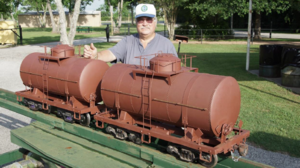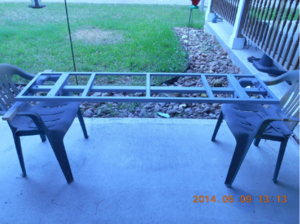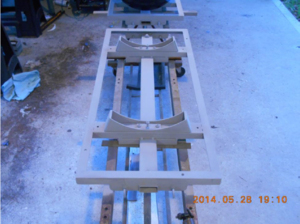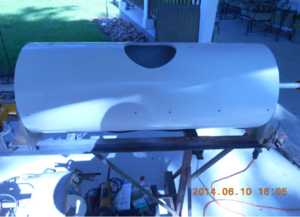Building Tank Cars
Gary T. Brothers

From "Stack Talk", September and November 2014, Houston Area Live Steamers.
All the tank cars need a frame to start with. Mine normally use a 1 by 2 inch rectangular steel tubing with shorter pieces creating a "tee" on both ends. The rectangular tubing is 1/4 inch longer on both ends so that the frame sticks out beyond the car ends. Spacing the shorter pieces of rectangular tubing between 7 and 8-1/2 inches from the end and welding all together. A hole is drilled at the center of both tees to place a 3/8 inch bolt then weld the head to the frame. The bolt sticks thru to hold the trucks in place and then a lock nut or cotter pin to keep the truck from falling off if the car is picked up to rerail. With Tom Bee trucks I add a 3/8th inch thick 2 inches wide and 7 inches long centered on the tees to keep the coupler height at the proper height from the rail.
Also, 3/8th inch holes are drilled in both ends depending on which coupler is used, between 1-3/4 to 2-1/2 inches from the end. I usually weld a lock nut on top of the frame and run the bolt from the bottom through the coupler to hold it in place.
Next comes the upper part of the frame consisting of 1 inch angle iron. These are welded together forming a rectangular frame work that will eventually sit on top of the spine or backbone of the car. The upper frame work or sub-assembly is placed on top of the lower frame work and all is welded together. My frames are generally 15 inches wide by how ever long they need to be for the tank car.
At this time, the stirrups can be either welded on all four corners and in the centers or bolted on. Also, dummy air tanks can be placed where desired. Mine are created from smaller PVC end caps and all glued together. They are mounted to the underside of the frame using flat aluminum bolted and small bolts into the "tanks" threaded into the bodies. The PVC will take bolt threads, usually 6-32 threads. Also the bracket has holes that are bolted to the frame again taping into the frame with a 6-32 tap.
At this time, locate where the tank saddles will go and mount to frame at the two body bolsters. Drill holes now where the tank straps will be as this will be easier now than later. Other holes to the frame can also be drilled now such as placard holders and brake wheel assemblies.
If safety chains will be a part of the car, then the locations for the eye bolts are drilled.
The tank car body consists of usually schedule 40 PVC pipe that has been cut to length. To get a square end, I take some aluminum flashing at least 6 inches wide and wrap around the pipe and both ends match up. This is taped together and sliding it where I want to cut, I mark all the way around the pipe either with a fine point marker or a pencil. After insuring the mark goes all the way around, I then slide the aluminum flashing out of the way of the cut line.
You can use a hand saw, PVC saw, or a circular saw using a fine or plywood blade. Be careful when cutting and take your time. Also, try to cut just outside of the line, this can be sanded later. Be sure to support the large pipe as you cut it to keep the saw from binding and possible kicking back. Cutting the pipe with a circular saw creates a lot of sawdust the will clog between the saw blade and the protective cover. Stop once in a while to clean this out.
The pipe body has now been cut to the desired length, slide the flashing back to the end and check to see if the ends are square and how much material needs to sanded off. Take a large square and check all the way around the pipe in several places. Sand or file until you are satisfied your ends are square.
To find the top and bottom lines, start off by locating the bottom line from end to end using a long piece of angle iron marking the line. Next, the top line will be marked exactly half way around checking in both directions to get equal measurement (on 12 inch schedule 40, half of just over 40 inches) and after locating, again take the angle iron and draw the line from end to end. Other lines such as the handrails, walkway, etc. will be marked where desired from the bottom line making sure all lines are the same placement.
Next, determine where the dome(s) will be. If only one then the center of the body. Also, at the center, draw a line all the way around using the straight edge of the flashing that was used in cutting the pipe's length. Locate where the tank saddles will be matching up with the body bolsters on the frame and draw another line all the way around again using the flashing straight edge. The bottom center of the lines will be where the bolts holding the tank to the frame through the saddles will be.
Other lines such as the hand rail brackets, walkway, ladders, and grab irons are marked. Once happy with the locations, holes can be drilled and tapped for the various bolts and screws that will go into the pipe body.
The openings for the domes are marked and cut with a jig saw then sanded with a drum sander in a drill until the dome's pipe fits into the tank body. Carefully sand keeping the drill vertical or straight up and down.
I use a jig or pattern for marking the hole and at the same time if rivets will be part of the build, I mark them using a small center punch. Tape holds the pattern in place while marking the outline of the home and also the rivets.
My domes use six inch PVC schedule 40 end caps held in place with a short piece of 6 inch pipe. The domes are saddle cut again using a pattern or jig I made sometime ago out of some aluminum flashing. Once satisfied where the saddle cuts will be, I use a jig saw to cut the cap to a rough form. After that, I use a table mounted belt sander to refine the cut more to shape checking often for fit in top of the tank body. Next, I clamp several wide strips of old belt sander belts around a scrap piece of twelve inch pipe same as the body and "lap" the cap back and forth until it fits on top of the tank body.
Somewhere while marking the tank body for the various holes if rivets are to be part of the built, lines are drawn locating each rivet. The lines I draw are usually 3/16th inch apart and each rivet is spaced 3/8th inch apart staggering between the two closely spaced lines. The above photo gives and idea of how I place them on a typical car or in this case, a three domed tank car.
After all the rivets are located, I center punch then drill for the rivets, in this case, no. 2 button head drive screws 3/8th inch long. A longer car can take more than 2000 rivets including those on the domes.



